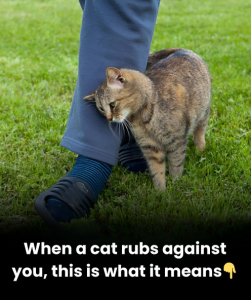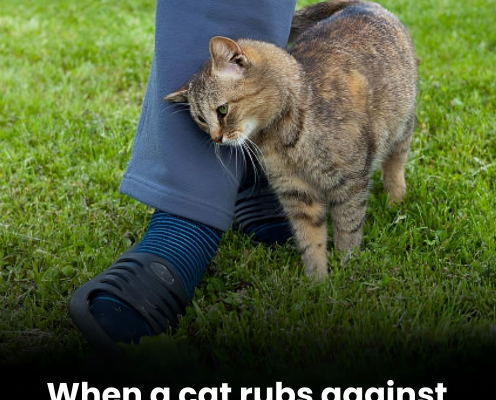
When a cat rubs against you, it might seem like a simple, affectionate gesture — but to your feline companion, it’s actually a deeply meaningful form of communication. Cats are creatures of subtlety, and almost everything they do carries layers of meaning rooted in instinct, biology, and social behavior. Understanding why your cat rubs against you and knowing how to respond can strengthen your bond and make your relationship with your pet even more rewarding.
Let’s explore what’s really happening when a cat brushes up against your legs, hands, or even your face — and what you should do in return.
Why Cats Rub Against You
When a cat rubs against you, it’s not just being affectionate; it’s marking you. Cats have scent glands located in various parts of their bodies — around the cheeks, forehead, lips, chin, tail base, and even along the sides of their body. These glands produce pheromones, chemical signals that cats use to communicate with other cats and their environment.
By rubbing against you, your cat is effectively saying, “You’re part of my family” or “You belong in my territory.” It’s a way of mixing your scent with theirs, creating a shared smell that brings them comfort and security. In the feline world, scent is everything. Cats recognize each other more through smell than sight, so scent-marking helps reinforce bonds and reduce tension.
Cats also rub on people or objects to spread their scent as a signal to other cats. If you have multiple cats at home, you may notice that they rub against the same furniture or even each other — this helps create a communal scent that strengthens their social group.
In short, rubbing isn’t just affection — it’s communication, trust, and a declaration of belonging all in one gesture.
The Many Ways Cats Rub
Not all rubs are the same, and the area your cat targets can tell you a lot about their mood and intentions.
1. Rubbing Against Your Legs
This is the most common behavior. It usually happens when you come home or when your cat wants attention or food. By weaving between your legs, your cat is both greeting you and depositing its scent. The circular movement reinforces the bond while reminding you that your cat sees you as part of its world.
2. Rubbing Its Face or Head Against You
This is one of the most affectionate signs. The glands on the cat’s cheeks and forehead are particularly rich in pheromones. When your cat presses its face against your hand, arm, or cheek, it’s marking you as “safe” and “trusted.” It’s also seeking reassurance — much like a human hug.
3. Rubbing Its Whole Body Along You
A cat that rubs its entire body against your leg or side is expressing full comfort and affection. This body rub often includes a tail wrap at the end, where the cat’s tail curls slightly around you. Think of it as the feline equivalent of a gentle embrace.
4. Rubbing Its Tail Base or Backside Near You
While this may seem strange or even rude to humans, it’s actually a sign of high trust. Cats are most vulnerable from behind, so if your cat turns its back and brushes against you, it’s showing that it feels completely safe in your presence.
What You Should Do When It Happens
1. Respond Gently and Positively
The best way to respond when your cat rubs against you is to acknowledge the gesture. You can speak softly, bend down to their level, and gently pet them along the head or cheeks — the areas where they have scent glands. This not only shows affection but also reinforces the bond they’re trying to build.
2. Let Your Cat Take the Lead
Cats value control and personal space. If your cat initiates contact, let it decide how much interaction it wants. Don’t grab or force it to stay in your arms; instead, allow it to come and go freely. Respecting a cat’s autonomy is one of the fastest ways to earn trust.
3. Offer a Slow Blink or Gentle Touch
In cat language, a slow blink is like saying, “I trust you.” Try looking at your cat and blinking slowly; if they return the gesture, it’s a sign of mutual affection. You can also lightly scratch the base of their ears or under the chin, as long as the cat appears relaxed and receptive.
4. Avoid Startling or Ignoring Them
If you push your cat away or ignore them completely, they may interpret that as rejection or hostility. While some cats are more independent, they still crave acknowledgment when they initiate physical contact. A gentle response tells them their communication was received.
What Rubbing Can Mean Emotionally
While rubbing is primarily about scent and bonding, it can also convey specific emotions depending on the situation.
-
Affection: A relaxed, purring cat that rubs against you simply wants to express love and comfort.
-
Greeting: After a period of separation (like coming home from work), rubbing serves as a friendly “welcome back.”
-
Attention-seeking: Some cats use rubbing as a polite way to say, “Feed me” or “Play with me.”
-
Reassurance: A cat may rub more frequently when it feels insecure or when there are changes in the environment. It’s their way of grounding themselves.
By paying attention to your cat’s body language — tail position, ear movement, vocalizations — you can better understand what kind of emotion is behind the rubbing.
When Rubbing Indicates Something More
Sometimes, rubbing can signal other underlying issues or needs.
1. Heat Behavior (in Unspayed Females)
A female cat in heat will often rub excessively against furniture, people, or the floor. This is part of her instinctual mating behavior, so if you notice increased rubbing paired with loud vocalizations and restlessness, spaying may be the solution.
2. Anxiety or Environmental Stress
Cats that feel anxious or uncertain might rub more to spread their scent and create familiarity in their surroundings. If your cat is rubbing excessively after a move, new pet, or major change at home, it’s likely seeking comfort through scent-marking.
3. Health Issues
While rare, sudden changes in rubbing behavior — especially rubbing the head or face on hard objects — could indicate irritation, ear infections, or dental discomfort. If rubbing seems compulsive or paired with signs of pain, a vet visit is advisable.
The Social Dimension of Rubbing
In multi-cat households, rubbing plays a crucial role in social dynamics. Cats that get along will often engage in mutual rubbing or “allorubbing,” where they brush against each other to exchange scents. This helps maintain harmony and signals peaceful coexistence.
When a cat rubs against a human, it’s essentially extending this same social ritual to you. You’ve been accepted as part of their group — a member of their family circle. In feline terms, that’s one of the highest honors you can receive.
Strengthening the Bond
Responding thoughtfully to your cat’s rubbing is one of the simplest ways to deepen your relationship. Here are a few extra tips to strengthen that connection:
-
Engage in regular play sessions. Shared activity mimics hunting behavior and reinforces trust.
-
Maintain a calm routine. Cats thrive on predictability; it helps them feel secure.
-
Use your scent. Leaving clothing or bedding that smells like you can comfort your cat when you’re away.
-
Practice positive touch. Pet your cat in areas it enjoys — typically the head, cheeks, and under the chin — and avoid overstimulating zones like the belly or tail.
Final Thoughts
When a cat rubs against you, it’s far more than a cute or random act — it’s a complex and intimate gesture rooted in communication, biology, and emotion. Your cat is not only showing affection but also expressing trust, ownership, and comfort in your presence.
The best thing you can do is respond with calm, gentle affection. Speak softly, offer a light pet, and let your cat guide the interaction. In doing so, you’re acknowledging their language — a silent conversation built on respect and connection.

